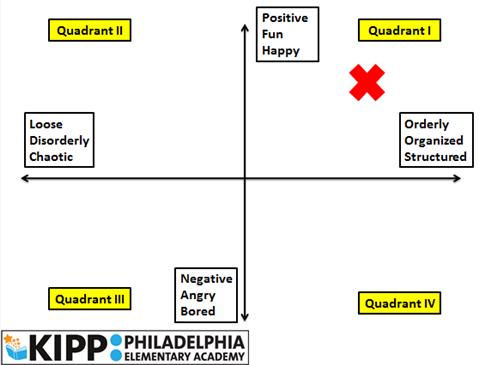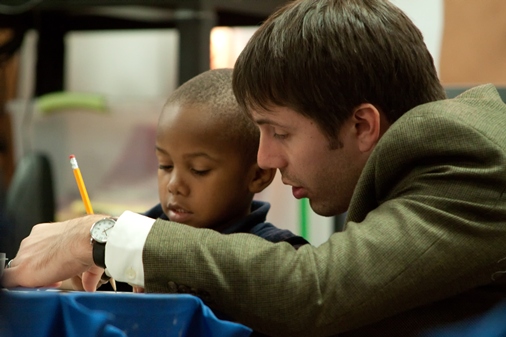By Ben Speicher, School Leader, KIPP Philadelphia Elementary Academy
When I was a Fisher Fellow spending a year visiting, observing, talking, traveling, and planning in preparation to open a KIPP elementary school in Philadelphia, friends who were familiar with KIPP would ask me what certain elements of KIPP’s model look like with 5-year olds. They had enough prior knowledge to know about some of the common behavior management systems used at many KIPP middle schools, like students earning a “paycheck” each week that monetizes all the good and bad choices they made that week. They might also have heard about “the porch” or “the bench” or other systems where middle school students lose privileges like sitting with their friends at lunch or sitting at their normal seat in class when they repetitively make poor choices.
While these systems work for our students in middle school, people often asked this question with an understandable amount of skepticism as they struggled to see how this would work with early elementary students.
As I told them, it wouldn’t. We were going to build strong student culture in a way that made sense for younger students, while also reflecting the big ideas that have been the foundation of KIPP’s success for almost 20 years. Character is just as important as academics. Holding students to high expectations. You need to teach, model, and practice how to be nice if kids are really going to do it. Structure and consistency are important. Families need to be actively involved. Etc.
Our guiding principle was to create a student culture that is structured, organized, and orderly, while also being fun, positive, and relaxed. We call this “staying in Quadrant I” as shown in the diagram: 
Some teachers and schools see these ideas as being in opposition, but we look at them as actually reinforcing each other. If we teach students what we expect and hold them accountable, we’ll have more time for dance parties. If we make learning fun for our students, they will be more likely to pay attention when they need to. If we have shown students that there are consequences for bad choices, then we can be more positive since students will be less likely to “test” their teachers. This is tough to pull off, but it’s what we aim for.
A classroom with students on task and working hard, but only doing it of fear for getting in trouble is not a strong classroom culture. Conversely, we also do not want a classroom where students are having fun and invested in learning, but where many minutes of instruction are wasted with students calling out or students transitioning noisily between activities.
So how do KIPP teachers stay in Quadrant 1?
We try to bring joy into everything we do. See my post on joy for more.
We call our students “friends” instead of boys and girls, scholars, or simply students. So we say, “Friends, I need your eyes on me right now” or, “That was not a good choice, friend.” It’s sort of hokey (ok, very hokey), but it makes the idea of a school being a team and a family ever-present for our students and for the staff too.
We have an amazing social skills curriculum that teaches students skills like following instructions, paying attention, and accepting “no” with three easy steps, fun songs, and colorful posters. Besides giving all teachers a common language (also a huge part of what we do with our values and behavior system), having students with a strong grounding in social skills will prevent a ton of misbehavior.
We teach five school values (joy, integrity, excellence, teamwork, and determination) to students in once-a-week classes led by me or our assistant principal and then woven throughout the rest of the day. We have an awesome values song that we sing all the time. Student actions are constantly being tied back to these values so students actually hear comments like, “I love how you helped your friend when his crayon fell. What a great example of teamwork!” all the time.
Each classroom uses the same behavior system that is a variation on a clothespin or color system common in almost every early elementary classroom. We emphasize the concept of “turning it around” and students can move their name back on the behavior chart as soon as they make good choices, whether that is in five minutes or five hours.
We send home a behavior report each night so families are in the loop with how their child is doing and can follow-up as they see fit. Our teachers all have school provided cell phones so families can get in touch easily and we have in-depth conferences twice a year with families.
We teach what our expectations are for each situation. For example sitting on the carpet, working at tables, getting in line, etc. Students know exactly what to do in each moment of the day and are corrected in a way that focuses on letting them know how to do it right. We say: “When we walk in the halls we have our hands at our sides.” Instead of: “I can’t believe you just did that!” We want the focus not to be on a student making a mistake, but on how to do it correctly next time.
We teach a structured conflict resolution process called “The Peace Path” where students learn to solve minor problems themselves. By November of kindergarten, students can go to the Peace Path, talk through the issue, apologize, and end it with a hug, high-five, or handshake. Besides cutting down on tattling, it also gives students ownership over their actions.
We are firm with consequences. Students have their name moved. They get on timeout (5 minutes max). If they have made a really bad choice, they get sent to the office. They miss recess. They get a bad behavior report. Families get called. Kids cry. And that’s ok because students need limits and need to understand that there are consequences when they make bad choices. But this part only works if we do all the rest and we discipline firmly, but not meanly. Teachers at KIPP do not yell at students. They speak firmly and strongly when they need to, but they never, ever yell. I sometimes do when I think that is the right choice, but that’s part of my job and I don’t want it to be part of my teachers’.
This post isn’t to imply that we have this figured out, because we don’t. Teaching little kids to read, add, and to be nice is tough! But I am convinced that we’re on the right track and that a school can be rigorous, safe, and calm while also being full of joy and positivity. In fact, that’s the best way to achieve both.
